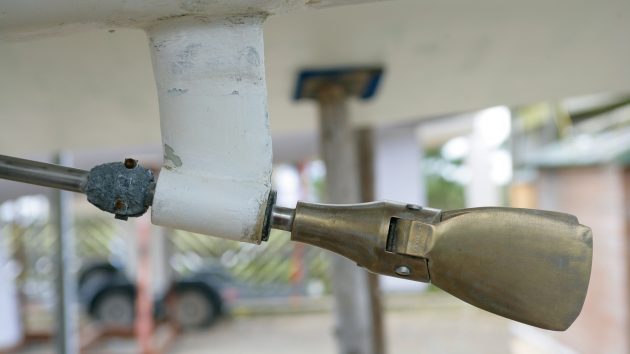Beyond a yacht's gearbox lies the stern gear, the coupling that connects the engine power to the propeller shaft
Astern of a yacht’s gearbox you will find the coupling that connects the power output shaft to the propeller shaft. The propeller shaft itself is usually made from a mild steel – a material that’s very good at transmitting power and absorbing sudden load changes, such as going from ahead to astern quickly. The propeller shaft then exits the boat via a stern tube, and then, of course, the propeller is located at the end of the propeller shaft, to finally transmit the power produced by the engine into the water.
Flexible mountings
Modern engines and gearboxes (which can be considered as a single unit) are mounted on flexible feet (mountings) to reduce noise and vibration. These mountings can deteriorate or fail completely, so regular checking of their condition is required.
A mounting normally comprises a metal bracket bonded onto a rubber flexible block, which, again, is bonded onto a metal bracket. The mounting is attached to the engine’s foot and to the boat’s structure. Normally there are four mounts on an engine, two each side, with the gearbox protruding beyond the aft mounts.
A larger set-up could have two mounts for the gearbox as well, giving six in total.

A shaft coupling mates the engine’s output shaft with the propeller shaft
Stern tube
The stern tube is simply a pipe either welded or glassed into the hull. Inside are one or two shaft bearings, often called cutless bearings. At the forward end of the stern tube there is a stern gland that stops water coming into the engineroom.
Many yachts have a much shorter pipe and then a shaft bracket, often called a P bracket because of its shape. This P bracket also has a cutless bearing in it. These cutless bearings are water cooled and lubricated, which is why they have grooves along their length to allow water to pass over them.
Stern gland
The stern gland (also referred to as a stuffing box) can be of two types: a packed gland or a mechanical seal type. The packed gland is an older type, but very forgiving. There should be a slight drip from these glands, which shows that the packing is being lubricated by the sea water.
The second type of gland is watertight, so there should be no leaks from it. The seal is made by two very smooth faces, one rotating and one static. These faces are on a moving ring on the shaft and a static ring on the end of the stern tube. Because the faces are both flat and smooth, no water should be able to pass between them.
Enjoyed reading this?
A subscription to Yachting Monthly magazine costs around 40% less than the cover price.
Print and digital editions are available through Magazines Direct – where you can also find the latest deals.
YM is packed with information to help you get the most from your time on the water.
-
-
- Take your seamanship to the next level with tips, advice and skills from our experts
- Impartial in-depth reviews of the latest yachts and equipment
- Cruising guides to help you reach those dream destinations
-
Follow us on Facebook, Twitter and Instagram.





